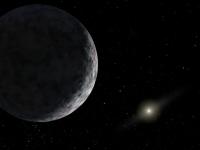Over the weekend, more news came in about 2003 UB313, the soon to be renamed new planet discovered at Palomar Observatory. As discussed in astronomer Mike Brown’s page on the discovery, 2003 UB313 is the largest object found orbiting the Sun since Neptune and its moon Triton in 1846. There seems to be no doubt that it is larger than Pluto and, like that planet, a member of the Kuiper Belt, a vast band of icy objects beyond Neptune. Remarkably, the 2003 UB313 team has found 80 bright Kuiper Belt objects since beginning its survey of the outer Solar System in 2001, but none so newsworthy as this one.
Artist2003 UB313 takes twice as long to orbit the Sun as Pluto, and it is currently more than three times more distant, although it moves in an elliptical orbit that can bring it within Pluto’s orbit and close to that of Neptune. Size limits can now be set ranging from 2210 to 3550 kilometers, depending on the nature of the surface and how it reflects light. Hubble measurements, already scheduled, should provide some firmer answers.
 Image: This artist’s concept shows the planet catalogued as 2003 UB313 at the lonely outer fringes of our solar system. Our Sun can be seen in the distance. The new planet, which is yet to be formally named, is at least as big as Pluto and about three times farther away from the Sun than Pluto. The planet was discovered by the Samuel Oschin Telescope at the Palomar Observatory near San Diego, Calif., on Jan. 8, 2005. Image credit: NASA/JPL-Caltech.
Image: This artist’s concept shows the planet catalogued as 2003 UB313 at the lonely outer fringes of our solar system. Our Sun can be seen in the distance. The new planet, which is yet to be formally named, is at least as big as Pluto and about three times farther away from the Sun than Pluto. The planet was discovered by the Samuel Oschin Telescope at the Palomar Observatory near San Diego, Calif., on Jan. 8, 2005. Image credit: NASA/JPL-Caltech.
Meanwhile, the surface of the new world, as examined by the team via the Gemini Observatory in Mauna Kea, show the signature of an object covered with frozen solid methane. Pluto shows much the same signature, although its surface is reddish as compared to the greyer tones of the new planet. But the similarity with Pluto remains striking; both worlds are on elongated elliptical orbits, and both orbits are tilted with regard to the rest of the Solar System.
And note this about the presence of methane: none has been found on any other Kuiper Belt object (KBO) other than Pluto and Neptune’s moon Triton. Initial spectra on the smaller object 2003 EL61, in contrast, show strong water ice features that resemble what is found on Pluto’s moon Charon. Complete results on this work will be presented at the 37th annual meeting of the Division for Planetary Sciences of the American Astronomical Society in September 2005 at the University of Cambridge, UK.
Is it legitimate to consider the new world a planet? Listen to Brown:
“The main stumbling block in defining planets in our solar system is that, scientifically, it is quite clear that Pluto should certainly not be put in the same category as the other planets. Some astronomers have rather desperately attempted to concoct solutions which keep Pluto a planet, but none of these are at all satisfactory, as they also require calling dozens of other objects planets. While people are perhaps prepared to go from 9 to 10 planets when something previously unknown is discovered, it seems unlikely that many people would be happy if astronomers suddenly said ‘we just decided, in fact, that there are 23 planets, and we decided to let you know right now.'”
Brown’s solution, the only one that makes sense, is to say that because our culture has accepted Pluto as a planet, we should simply use it as our baseline, and say that any objects larger than Pluto are themselves planets. “Thus, we declare that the new object, with a size larger than Pluto is indeed a planet,” Brown adds, a common sense resolution to an issue that will continue to be debated in many scientific circles.
Meanwhile, the hunt for Kuiper Belt objects continues. 2005 FY9, itself brighter than any KBO known before the recent discoveries and about half the size of Pluto, was announced by Brown’s team on the same day as 2003 UB313. If discoveries continue at this pace, choosing appropriate names will become a growth industry.

